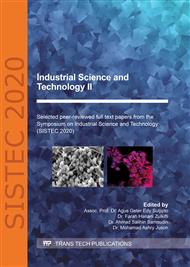[1]
T. D. Giles, B. J. Materson, J. N. Cohn, and J. B. Kostis, Definition and classification of hypertension: an update,, J. Clin. Hypertens., vol. 11, no. 11, p.611–614, (2009).
DOI: 10.1111/j.1751-7176.2009.00179.x
Google Scholar
[2]
S. Jain and S. C. Joshi, Development of transdermal matrix system of captopril based on cellulose derivative,, Pharmacolgyonline, vol. 1, p.379–390, (2007).
Google Scholar
[3]
F. Gohar, S. M. Greenfield, D. G. Beevers, G. Y. H. Lip, and K. Jolly, Self-care and adherence to medication: a survey in the hypertension outpatient clinic,, BMC Complement. Altern. Med., vol. 8, no. 1, p.4, (2008).
DOI: 10.1186/1472-6882-8-4
Google Scholar
[4]
K. A. S. Al-Japairai et al., Current trends in polymer microneedle for transdermal drug delivery,, Int. J. Pharm., vol. 587, (2020).
Google Scholar
[5]
M. Azmana, S. Mahmood, A. R. Hilles, U. K. Mandal, K. A. S. Al-Japairai, and S. Raman, Transdermal drug delivery system through polymeric microneedle: A recent update,, J. Drug Deliv. Sci. Technol., vol. 60, p.101877, (2020).
DOI: 10.1016/j.jddst.2020.101877
Google Scholar
[6]
S. Mahmood, M. Taher, and U. K. Mandal, Experimental design and optimization of raloxifene hydrochloride loaded nanotransfersomes for transdermal application,, Int. J. Nanomedicine, vol. 9, p.4331, (2014).
DOI: 10.2147/ijn.s65408
Google Scholar
[7]
M. R. Prausnitz and R. Langer, Transdermal drug delivery,, Nat. Biotechnol., vol. 26, no. 11, p.1261–1268, (2008).
DOI: 10.1038/nbt.1504
Google Scholar
[8]
M. M. R. Siddiqui, S. S. B. Mosharraf, R. S. Giasuddin, N. Islam, and S. Mirza, What is New in New Generation Calcium Channel Blocker,, Anwer Khan Mod. Med. Coll. J., vol. 10, no. 1, p.77–83, (2019).
DOI: 10.3329/akmmcj.v10i1.43666
Google Scholar
[9]
Y. Ozawa, K. Hayashi, and H. Kobori, New generation calcium channel blockers in hypertensive treatment,, Curr. Hypertens. Rev., vol. 2, no. 2, p.103–111, (2006).
DOI: 10.2174/157340206776877370
Google Scholar
[10]
T. F. Lüscher and F. Cosentino, The classification of calcium antagonists and their selection in the treatment of hypertension,, Drugs, vol. 55, no. 4, p.509–517, (1998).
DOI: 10.2165/00003495-199855040-00003
Google Scholar
[11]
R. Jain, M. Aqil, A. Ahad, A. Ali, and R. K. Khar, Basil oil is a promising skin penetration enhancer for transdermal delivery of labetolol hydrochloride,, Drug Dev. Ind. Pharm., vol. 34, no. 4, p.384–389, (2008).
DOI: 10.1080/03639040701657958
Google Scholar
[12]
S. Bindhani, U. Mohapatra, S. Mohapatra, and R. K. Kar, Enhancement of Solubility and Dissolution Rate of Poorly Soluble Drug Nifedipine by Solid Sedds,, Int. J. Drug Deliv. Technol., vol. 10, no. 1, p.9–15, (2020).
DOI: 10.25258/ijddt.10.1.3
Google Scholar
[13]
G. Chandra, K. S., & Ramesh, The fourth-generation Calcium channel blocker: cilnidipine,, Indian Heart J., vol. 65, no. 6, p.691–695, (2013).
DOI: 10.1016/j.ihj.2013.11.001
Google Scholar
[14]
S. Güngör and Y. Özsoy, Systemic delivery of antihypertensive drugs via skin,, Ther. Deliv., vol. 3, no. 9, p.1101–1116, (2012).
DOI: 10.4155/tde.12.87
Google Scholar
[15]
R. Muzzalupo and L. Tavano, Niosomal drug delivery for transdermal targeting: recent advances,, Res. reports transdermal drug Deliv., vol. 4, p.23, (2015).
DOI: 10.2147/rrtd.s64773
Google Scholar
[16]
V. R. Yasam et al., A novel vesicular transdermal delivery of nifedipine–preparation, characterization and in vitro/in-vivo evaluation,, Drug Deliv., vol. 23, no. 2, p.619–630, (2016).
DOI: 10.3109/10717544.2014.931484
Google Scholar
[17]
B. Morakul and V. B. Junyaprasert, Proniosomes: An effective carrier for dermal and transdermal delivery,, (2019).
Google Scholar
[18]
M. Yusuf, V. Sharma, and K. Pathak, Nanovesicles for transdermal delivery of felodipine: Development, characterization, and pharmacokinetics,, Int. J. Pharm. Investig., vol. 4, no. 3, p.119, (2014).
DOI: 10.4103/2230-973x.138342
Google Scholar
[19]
K. D. Dhondge, D. M. Patil, A. A. Patak, and D. S. Pachpute, Formulation development and characterization of transdermal film of nisoldipine,, Int J Pharm Sci, vol. 5, p.313–323, (2014).
Google Scholar
[20]
M. Yasir, M. Asif, A. Kumar, and A. Aggarval, Biopharmaceutical classification system: An account,, Int. J. PharmTech Res., vol. 2, no. 3, p.1681–1690, (2010).
Google Scholar
[21]
G. M. El Maghraby, A. A. Ahmed, and M. A. Osman, Penetration enhancers in proniosomes as a new strategy for enhanced transdermal drug delivery,, Saudi Pharm. J., vol. 23, no. 1, p.67–74, (2015).
DOI: 10.1016/j.jsps.2014.05.001
Google Scholar
[22]
Y. Luo, L. Ren, M. Jiang, and Y. Chu, Anti-hypertensive efficacy of amlodipine dosing during morning versus evening: A meta-analysis,, Rev. Cardiovasc. Med., vol. 20, no. 2, p.91–98, (2019).
DOI: 10.31083/j.rcm.2019.02.31814
Google Scholar
[23]
H. Kapoor, M. Aqil, S. S. Imam, Y. Sultana, and A. Ali, Formulation of amlodipine nano lipid carrier: formulation design, physicochemical and transdermal absorption investigation,, J. Drug Deliv. Sci. Technol., vol. 49, p.209–218, (2019).
DOI: 10.1016/j.jddst.2018.11.004
Google Scholar
[24]
M. M. Shete, Cilnidipine: Next generation calcium channel blocker,, J Assoc Physicians India, vol. 64, no. 4, p.95–99, (2016).
Google Scholar
[25]
R. Diwan, P. R. Ravi, N. S. Pathare, and V. Aggarwal, Pharmacodynamic, pharmacokinetic and physical characterization of cilnidipine loaded solid lipid nanoparticles for oral delivery optimized using the principles of Design of Experiments,, Colloids Surfaces B Biointerfaces, p.111073, (2020).
DOI: 10.1016/j.colsurfb.2020.111073
Google Scholar
[26]
K. Khatoon, M. Rizwanullah, S. Amin, S. R. Mir, and S. Akhter, Cilnidipine loaded transfersomes for transdermal application: Formulation optimization, in-vitro and in-vivo study,, J. Drug Deliv. Sci. Technol., vol. 54, p.101303, (2019).
DOI: 10.1016/j.jddst.2019.101303
Google Scholar
[27]
N. Jain, A. Argal, and G. Gautam, Elastic liposomes mediated transdermal delivery of verapamil hydrochloride,, J. Drug Deliv. Ther., vol. 8, no. 6, p.16–21, (2018).
DOI: 10.22270/jddt.v8i6.2073
Google Scholar
[28]
R. Parhi and P. Suresh, Transdermal delivery of Diltiazem HCl from matrix film: Effect of penetration enhancers and study of antihypertensive activity in rabbit model,, J. Adv. Res., vol. 7, no. 3, p.539–550, (2016).
DOI: 10.1016/j.jare.2015.09.001
Google Scholar


